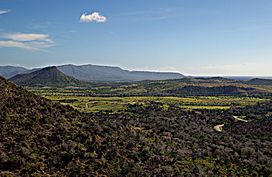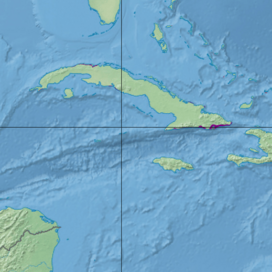Cuban cactus scrub facts for kids
Quick facts for kids Cuban cactus scrub |
|
|---|---|

Near Caimanera, Guantánamo Province
|
|

Ecoregion territory (in purple)
|
|
| Ecology | |
| Biome | Deserts and xeric shrublands |
| Bird species | 244 |
| Mammal species | 32 |
| Geography | |
| Area | 3,300 km2 (1,300 sq mi) |
| Country | Cuba |
| Conservation | |
| Conservation status | Vulnerable |
| Habitat loss | 23% |
| Protected | 28.31% |
The Cuban cactus scrub is a special natural area, or ecoregion, in Cuba. It's a type of dry, bushy land that covers about 3,300 square kilometers (1,300 sq mi). You can find it along the sheltered coast of Cuba.
Most of this ecoregion is in the southeastern part of the island. It's mainly in the Guantánamo and Santiago de Cuba provinces. This area gets very little rain, less than 800 millimeters (31 in) each year. The main soils here are called coastal rendzinas. These soils come from coral limestone found near the coast.
The Cuban cactus scrub has four main types of plant areas. These are: dry coastal scrubland, thorny coastal semidesert, hard-leaf coastal scrubland, and rocky coastal scrublands. Each zone has different kinds of plants that are suited to the dry conditions.
Contents
Dry Coastal Scrubland
This area is called "xerophytic coastal and subcoastal scrubland." "Xerophytic" means the plants are very good at living in dry places. The plants here can grow up to 6 meters (20 ft) tall. This zone is mostly filled with palms and succulents. Succulents are plants that store water, like cacti.
Many types of evergreen plants grow here. Some common ones include Bourreria virgata, Capparis cynophallophora, and Eugenia foetida. You can also find Bursera glauca and Bursera cubana. Other plants are Croton species, Cordia species, and Calliandra colletioides. Some thorny plants like Caesalpinia and Acacia species also thrive here.
Typical succulents include different types of Opuntia cacti, like Opuntia stricta. There are also Harrisia eriophora and Harrisia taetra. Tall cacti like Pilosocereus polygonus and Dendrocereus nudiflorus are common. You'll also see Agave species, which are large succulents, and Melocactus species, which look like spiky balls.
Thorny Coastal Semidesert
The coastal thorny semidesert is quite similar to the dry coastal scrubland. Plants in this zone also grow up to 6 meters (20 ft) tall. They have the same kinds of succulents. However, succulents make up a smaller part of the plant life here.
Other plants found in this zone include Cordia sebestena, which has bright orange flowers. You might also spot the Hippomane mancinella, which is known for its poisonous sap. Another plant is Plumeria filifolia, a type of Plumeria with beautiful flowers.
Hard-Leaf Coastal Scrubland
The plants in this zone are called "sclerophyllous." This means their leaves are hard and stiff. This helps them save water in dry conditions. The vegetation here usually reaches about 3 meters (10 ft) tall. Some taller trees can grow up to 5 to 6 meters (16 to 20 ft).
This zone is a transition area. It's where the dry scrublands start to blend into the slightly wetter dry forests. Plants you might see include Picrodendron baccatum and Maytenus buxifolia. Other trees are Pictetia spinosa, Brya ebenus, and Diospyros grisebachii.
Rocky Coastal Scrublands
This zone has the fewest and smallest plants. It's found right next to the ocean on karstic soil. Karstic soil is rocky and uneven, often formed from dissolved limestone. The plants here are very tough. They can handle strong winds and salt spray from the ocean.
Some of the plants that grow in these harsh conditions include Borrichia arborescens. You can also find Argusia gnaphalodes and Sesuvium maritimum. These plants are specially adapted to survive in a salty, windy environment.
Animals of the Scrub
The Cuban cactus scrub is home to many interesting animals. Many Birds live here. These include the Zapata sparrow (Torreornis inexpectata sigmani). You might also see the Cuban vireo (Vireo gundlachii) and the Cuban gnatcatcher (Polioptila lembeyei). The Oriente warbler (Teretistris fornsi) is another bird found in this area.
This ecoregion also has unique amphibians and reptiles. The yellow-striped pygmy eleuth (Eleutherodactylus limbatus) is a tiny frog. It is endemic to this area, meaning it's found nowhere else in the world. Several types of anole lizards are also endemic here. The Cuban rock iguana (Cyclura nubila nubila) is another special lizard that lives only in this region.
See also
 In Spanish: Matorral de cactáceas de Cuba para niños
In Spanish: Matorral de cactáceas de Cuba para niños

